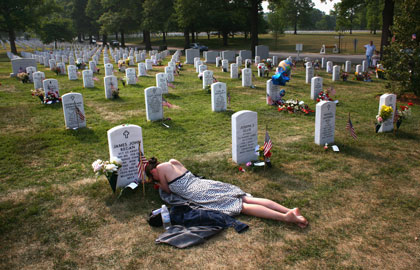-
 Decoration Day was originally designed to commemorate the fallen Civil War soldiers.
Decoration Day was originally designed to commemorate the fallen Civil War soldiers. On May 5th, 1868, General John A. Logan spoke the following:
The 30th of May, 1868, is designated for the purpose of strewing with flowers, or otherwise decorating the graves of comrades who died in defense of their country during the late rebellion, and whose bodies now lie in almost every city, village, and hamlet churchyard in the land. In this observance no form of ceremony is prescribed, but posts and comrades will in their own way arrange such fitting services and testimonials of respect as circumstances may permit.
This was the first official recognition of Decoration Day — or, as it was later named, Memorial Day.
On that May day in 1868, during the first celebration, General James Garfield (later the twentieth U.S. President, and, incidentally, one of the last great Presidents this country has had) gave a moving speech at Arlington National Cemetery. After his speech was concluded, 5,000 participants decorated the graves of the more than 20,000 Union and Confederate soldiers buried in Arlington Cemetery.
Two years prior to that, however, in May of 1866, in Waterloo, New York, a druggist named Henry Carter Welles (1821 – 1868), born in Glastonbury, Connecticut, suggested, rather nonchalantly at a social gathering, that a formal act of honor be shown the patriotic dead of the Civil War. He suggested a panegyric in which the townspeople decorate the graves of these fallen soldiers. A committee was subsequently formed, the stated purpose of which was “to obtain national recognition of the fact that Waterloo is the birthplace of Memorial Day through Congressional action [and] to plan and execute a proper celebration for such centennial observance.”
The next year, in May of 1866, Henry Carter Welles pitched this same idea to one General John B. Murray, who at that time was the Seneca County clerk. General John Murray went gaga over the idea of a nationwide holiday honoring the fallen Civil War soldiers, and the rest is history: Waterloo, New York was soon recognized by the United States government as “The Birthplace of Decoration Day.”
To us, this official recognition may sound like small potatoes, but in fact it was a difficult process to establish if Waterloo was the actual birthplace of Decoration Day: it required meticulous research to prove the claim, since a number of other communities in the country had long held informal observances in honor of the Civil War dead — and, indeed, to this day a number of communities still claim to be the birthplace of Memorial Day.
Here are a few of those communities:
Columbus, Missouri; Macon, Georgia; Richmond, Virginia; Boalsburg, Pennsylvania; Carbondale, Illinois.
Each year at Arlington National Cemetery, Memorial Day is celebrated with a somber ceremony in which a small American flag is placed upon each grave. It is also customary for the President or Vice President to give a completely phony speech, which insults the brave soldiers who have died for this country, and then to lay a wreath at the Tomb of the Unknown Soldier.
“About 5,000 people attend the ceremony annually…. Several Southern states continue to set aside a special day for honoring the Confederate dead, which is usually called Confederate Memorial Day” (Source).
Memorial Day



2 Responses and Counting...
The concept of the tomb of the unknown soldier is brilliantly developed in Benedict Anderson’s Imagined Communities,
http://www.amazon.com/Imagined-Communities-Reflections-Nationalism-Edition/dp/1844670864/ref=sr_1_1?ie=UTF8&qid=1338590040&sr=8-1
Hmmm. I’d never heard of that. Thank you, Doc.